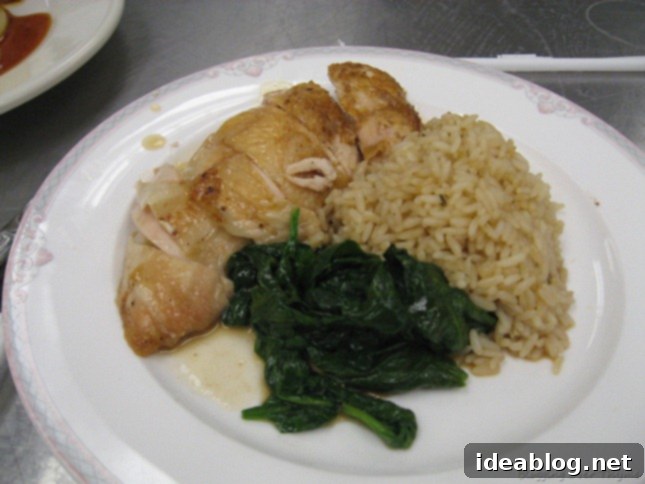Culinary School Day 8: Mastering French Protein Cookery, Classic Jus, and Elegant Desserts
What an incredible and information-packed day it was at culinary school! Today’s session was a true immersion into new techniques and a wealth of knowledge, particularly as we ventured into the exciting realm of protein cookery. While I’ll reserve the recap of today’s whirlwind for a future post, I’m eager to share all the exhilarating details from Wednesday’s class, specifically Day Eight of our intensive culinary program.
This marked a significant milestone: our first official day dedicated to cooking protein. Up until now, our experience with poultry had primarily involved meticulous butchery—trimming hundreds of pounds of chicken and expertly breaking down whole birds. However, the act of actually cooking these proteins, transforming them into delicious dishes, was an entirely new and highly anticipated challenge. Though my personal diet at home doesn’t heavily feature meat, the opportunity to delve into butchery and sophisticated meat cookery has been one of the aspects I’ve most eagerly looked forward to exploring in culinary school. There’s so much to learn, and this day truly underscored that depth of knowledge required.
Reflecting on the week, yesterday’s menu delivered what has, to date, been my absolute favorite meal in the entire program. Each dish was a testament to the power of classic French techniques, resulting in truly yummy and memorable flavors.
The Art of Roasting Chicken: Le Poulet Roti au Jus
The star of the day’s elaborate menu was undoubtedly LE POULET ROTI AU JUS, or Roasted Chicken with Jus. This wasn’t just any roasted chicken; it involved a sophisticated approach that deviated from traditional roasting methods. The process was rich in technique, demanding precision and attention to detail at every step. Yet, the final outcome was undeniably worth every effort, yielding an incredibly juicy chicken, bursting with profound flavor – a dish that truly tasted even better than it looked.
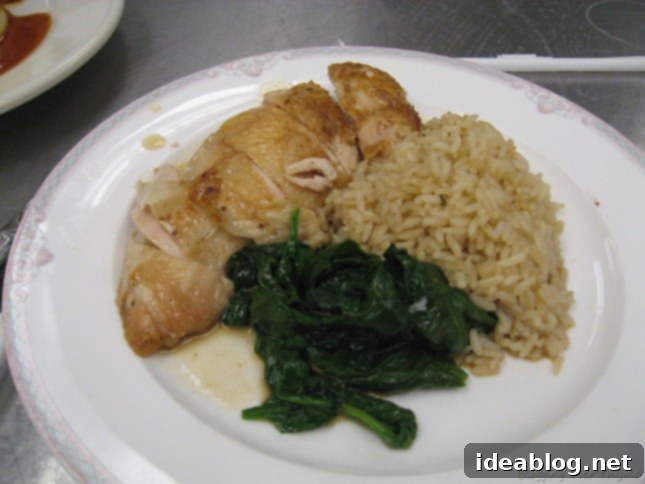
Preparing the Chicken for Roasting
To achieve this exquisite dish, we meticulously followed a series of preparatory steps designed to optimize both flavor and texture:
- Wing Removal: Our first task involved carefully removing the chicken wings. These weren’t discarded but thoughtfully saved, destined to become a crucial component in the rich, flavorful jus sauce we would create later.
- Trussing the Bird: Next, we expertly trussed the chicken. This fundamental culinary technique involves using butcher’s twine to tightly secure the legs and wings close to the body. Trussing serves multiple critical purposes: it helps protect the delicate breast meat from drying out during cooking, ensures more even cooking by compacting the bird into a uniform shape, and significantly enhances the final presentation and ease of carving.
- Seasoning and Stuffing: With the bird trussed, we seasoned it generously with salt and freshly ground pepper. We then carefully stuffed the cavity with a classic mirepoix—a aromatic mixture of finely chopped carrots, onions, and celery. This aromatic stuffing contributes subtle, savory notes to the chicken from the inside out as it roasts.
The Searing Process: Building Flavor and Texture
Then came arguably the most interesting and impactful part of the preparation: the searing! We took the entire prepared bird, complete with its mirepoix stuffing, and carefully seared it in a hot skillet containing clarified butter. Using our specialized kitchen forks, which allowed for precise maneuvering, we concentrated the searing specifically on the legs and thighs. This focused searing technique serves several vital functions: it helps to render out some of the chicken fat (which, in general, is not desired in large quantities and we aim to minimize), develops a beautiful golden-brown color and a crisp skin through the Maillard reaction, and critically, helps to ensure that all parts of the bird will achieve an equally moist and succulent texture once the roasting process is complete. This initial intense heat locks in moisture and sets the stage for deep flavor development.
Achieving Perfection in the Oven
After the crucial searing step, we added more fresh mirepoix to the skillet, providing an aromatic bed for the chicken. The skillet was then transferred directly into a preheated oven, set at approximately 375 degrees Fahrenheit. The chicken roasted until it reached optimal doneness, indicated by clear juices running when pierced with a fork (a pink hue signifies it is still undercooked). For our specific service needs, we strategically removed the chicken while it was still slightly pink internally. This allowed us to carve it expertly and then gently reheat it just before serving, preventing any risk of overcooking and drying out the succulent meat. Throughout the roasting period, we diligently basted the chicken every 15-20 minutes with the flavorful pan juices, a technique essential for maintaining exceptional moisture and infusing the skin with rich flavor.
Crafting the Exquisite Jus: Pincer and Monte au Beurre
Once the perfectly roasted bird was removed from the oven, we proceeded with the final, intricate steps to create the accompanying jus:
- Mirepoix and Fat Management: We carefully reserved all the delicious roasted mirepoix from the skillet and meticulously drained off any excess fat from the concentrated pan juices, ensuring a clean, flavorful base for our jus.
- Expert Carving: The legs were removed (and in our case, reserved for today’s menu, highlighting ingredient utilization), and the entire chicken breasts were carefully carved off, whole. This process mirrors the technique for breaking down a raw chicken, but with the added challenge of handling a piping hot bird that is now much more pliable.
- Combining Aromatics: Once the meat was removed, we combined the mirepoix stuffing from the chicken’s cavity with the mirepoix already in the skillet, intensifying the aromatic foundation for our jus.
- The Pincer Technique: We then literally “hacked” the chicken spine and back into smaller pieces, along with the wings that had been removed earlier. These bone pieces were added to a hot sautoir (a straight-sided, shallow pan) where they were allowed to caramelize deeply. This technique, known as PINCER, is fundamental for developing a rich, complex flavor base for stocks and sauces, as bones are packed with inherent savory notes that are released through careful browning.
- Enhancing with Herbs: The combined mirepoix was then seasoned with fresh thyme, fragrant garlic, and a bay leaf, layering additional aromatic complexities into the jus.
- Deglazing and Simmering: The caramelized chicken bones were deglazed with chicken stock, scraping up all the flavorful fond from the pan. The seasoned mirepoix was then added to this mixture, and everything was allowed to gently simmer for a period, allowing all the flavors to meld and deepen.
- Refining the Jus: Finally, this entire mixture was meticulously passed through a chinois—an extremely fine mesh conical strainer. This crucial step removes all bones, vegetable solids, and small bits, leaving us with a perfectly clear, intensely flavorful, and dark jus. We finished this exquisite jus with a small pat of butter, swirled in at the end (a technique known as monte au beurre, which literally translates to “mount with butter”), adding a silken texture and a beautiful sheen. So French, isn’t it?
Beyond the Main: Flavorful Rice Pilaf
As an ideal accompaniment to our perfectly roasted chicken, we also prepared a delectable rice pilaf. The result was absolutely delicious, complementing the rich flavors of the chicken and jus beautifully. I’m excited to share our unique technique for preparing this pilaf in a future post, as it involves some unconventional methods—we don’t use traditional lids and finish cooking it directly in the oven. Sounds intriguing, doesn’t it?
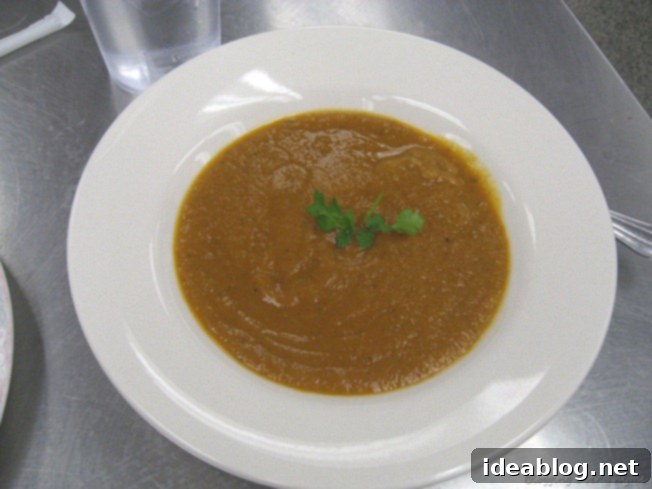
A Culinary Surprise: Roasted Eggplant Soup
In addition to our exquisite roasted chicken, we also prepared LA SOUPE D’AUBERGINE ROTIE, or Roasted Eggplant Soup. This dish was another revelation and quickly became a personal favorite! Seriously, give me a comforting, flavorful soup alongside a truly well-executed roasted chicken, and I’m content any day of the week.
Simple Steps to a Rich Flavor
I am so enthusiastic about this soup that I fully intend to recreate it in the very near future, perhaps even this coming weekend! A recipe post sharing the details will likely be on its way to you all. It was a surprisingly straightforward recipe, delivering complex flavors with relative ease.
The process began by taking a whole eggplant, halving it lengthwise, and generously rubbing the cut surfaces with olive oil and a delightful blend of toasted and ground cumin seeds. This prepared eggplant was then roasted until it became incredibly soft and tender. Once cooled slightly, we carefully scooped out the luscious interior flesh, reserving it for the soup. Meanwhile, we sautéed some finely chopped celery and onion until translucent, forming the aromatic base of our soup. To this, we added rich stock, followed by canned diced tomatoes, our reserved roasted eggplant ‘innards,’ and a thoughtful array of additional seasonings, including a touch of cayenne pepper for warmth and fresh cilantro for brightness. After allowing all these ingredients to simmer gently, melding their flavors beautifully, we transferred the entire mixture to a blender, transforming it into a velvety smooth and incredibly satisfying soup.
I understand that this particular roasted eggplant soup isn’t always included in Phase I of the curriculum, so I feel particularly fortunate that we had the opportunity to learn and prepare such a fantastic dish.
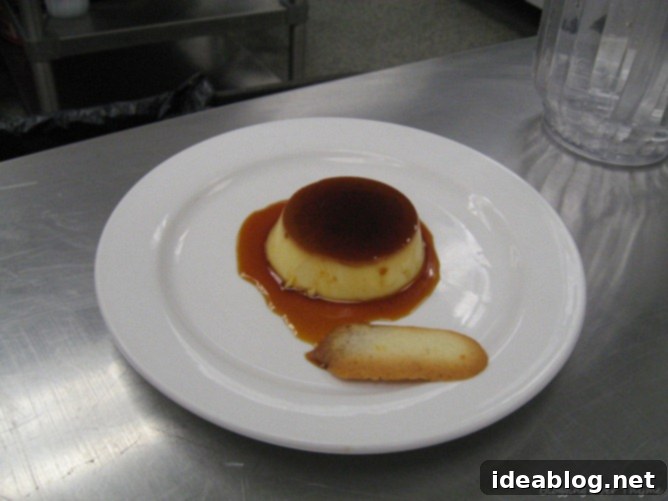
Sweet Endings: French Custards and Cookies
As if the savory delights weren’t enough, our busy day also included crafting two classic French desserts: crème caramel, a timeless custard, and LES PETITS FOURS SEC. The latter, meaning ‘little fire,’ refers to small, crisp dry cookies, which in this instance, were expertly piped into the delicate shape of Langue de Chat, literally “cat’s tongue” cookies.
The Elegance of Crème Caramel
Crème Caramel holds a special place in my heart as one of my absolute favorite desserts, owing to its simple elegance and profound deliciousness. The process is deceptively straightforward: you begin by preparing a delicate custard, exquisitely infused with the bright zest of orange and lemon, and the fragrant essence of vanilla bean. The crucial element that elevates this dessert is the deliciously bitter caramel sauce. This is made by carefully cooking a mixture of water, sugar, and corn syrup until it reaches a deep, dark caramel stage. A small amount of this molten caramel is then poured into the bottom of individual ramekins, creating a rich, amber base. The prepared custard mixture is then gently poured over the caramel. The ramekins are then placed in a water bath and baked in a very low-heat oven, typically between 275-300 degrees Fahrenheit, and never hotter. This precise low-temperature baking in a water bath is absolutely essential; it ensures that the delicate egg proteins in the custard cook gently and evenly, resulting in an incredibly smooth, tender, and silken texture, preventing any curdling. Once baked and cooled, the custard is inverted onto a plate, allowing the exquisite, molten caramel sauce to cascade elegantly over the custard, creating a stunning presentation and a harmonious blend of flavors.
The caramel is intentionally cooked to a very dark stage, which cooks out most of the pure sweetness from the sugar, bringing forth a delightful bitter quality. This perfectly balances the inherent sweetness of the sugary custard, creating a sophisticated and irresistible dessert experience. Yum!
Delicate Bites: Les Petits Fours Sec
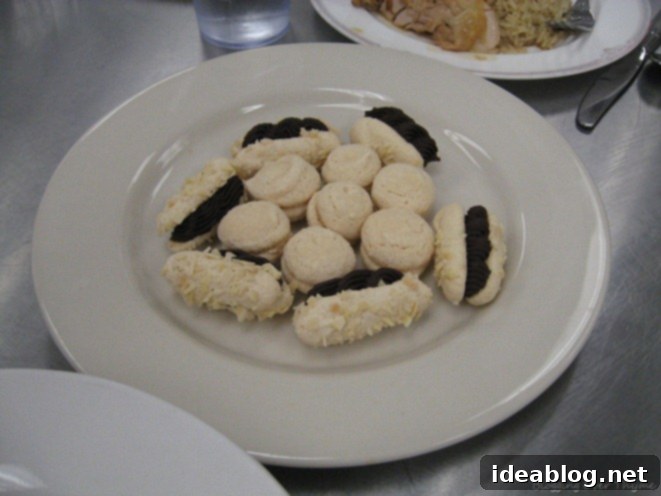
As if our own culinary creations weren’t enough to tempt our appetites at lunch, students from the pastry program generously brought us these beautiful treats. (My mind is currently blanking on the specific name of these delicate pastries – a clear sign I need more sleep!). Their exquisite presentation and delicious flavor added another layer of sweetness to an already delightful meal.
Reflections and Future Endeavors
All things considered, it was an immensely successful and delicious lunch that brought me immense satisfaction to prepare, learn about, and, of course, EAT! My cooking partner, Turner, and I had the gratifying experience of being among the first to complete our plates on time for the most part, which served as a wonderful and affirming conclusion to a demanding day.
The Business of Bites: Understanding Food Costing
The afternoon lecture pivoted from hands-on cooking to the vital business side of the culinary world, focusing entirely on food costing. This topic, which I find genuinely fascinating and incredibly practical, is essential for any aspiring chef or restaurant owner. At its core, food costing involves a relatively simple mathematical approach, but its implications are profound. It’s all about meticulously calculating the true, precise cost of a dish—literally, how much it costs in terms of raw ingredients. This foundational understanding is then used to intelligently determine a viable menu price or sale price. Generally, successful restaurants strive to keep their true food costs below 30% of their selling price to ensure profitability. This critical metric helps manage inventory, plan menus effectively, and ultimately ensures the financial viability of a culinary establishment. This is a topic I’m eager to delve into more deeply as my culinary education progresses and I gain more practical experience.
With all the incredible knowledge gained, I fully intend to make the roasted chicken at home for Connor tomorrow night. This isn’t just for practice; it’s a testament to how exceptional the dish was and how eager I am to master it. Here’s hoping it turns out just as well, if not better, with the experience from culinary school fresh in my mind! Now, I just need to remember to buy some kitchen twine for trussing…
Stay tuned for my next update, a summary of Day 9, which will also mark the end of Week 3 in culinary school!
